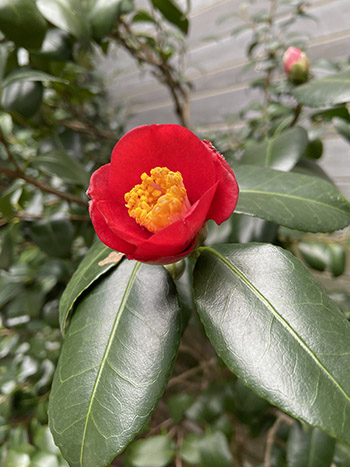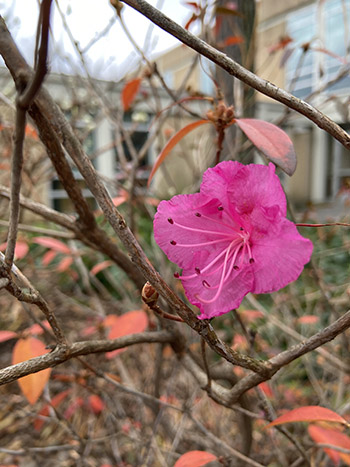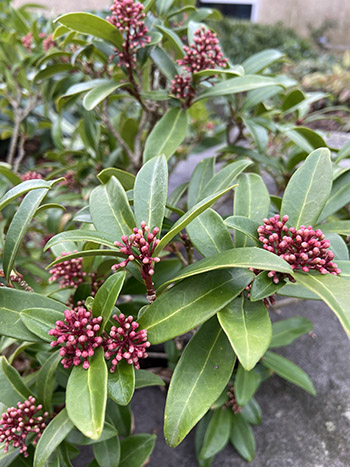
Plants of the Week: Dec. 14

Camellia japonica ‘Korean Fire’ – Japanese camellia
It was, and continues to be a year of odd weather. The hottest and driest of summers in a long while, and the beginnings of an up and down winter; with very cold days followed by very warm days. These odd patterns of weather are not only challenging when it comes to how many jackets you need to walk out the door with, but the plants themselves are also very confused. One confused plant in particular is the Camellia japonica ‘Korean Fire’, normally a spring blooming Japanese camellia, which is currently in full bloom.
One of the best winter hardy Camellia japonica cultivars, this plant was introduced by Barry Yinger through Hines Nursery from cuttings collected in Korea in 1984. Receiving the Pennsylvania Horticulture Society Gold Medal in 2003, this plant is dutifully located in the Scott Arboretum Gold Medal Garden. It is tucked away on the north side of Alice Paul Hall and is a great example of a good camellia planting location. While being protected from wind and direct afternoon sunlight, this specimen is grown in an area that has consistent and even moisture – all such conditions that a Camellia japonica needs to thrive.
Normally, Camellia japonica ‘Korean Fire’ blooms in March through May in the northern Hemisphere. Due to the dry, hot summer and the persistence of mild temperatures throughout the early winter, this specimen was triggered to bloom earlier. Chances are it will not bloom again in spring or will do so with less proliferation. I suggest you catch its lovely blooms now while you can, because its funnel-shaped, deep red flowers are truly such a delight. Photo credit: M. Rossman

Rhododendron ‘Milestone’ – rhododendron
One of the gardens that really seems to be hitting its stride for late-season interest is the Harry Wood Courtyard Garden: camellias, daphnes, and now a Rhododendron ‘Milestone’. Previously known as ‘Marathon’, this rhododendron is a hybrid between R. dauricum var. sempervirens and R. minus var. compactum. The result of this cross has produced a specimen that has both heat and cold tolerance. This rhododendron is a densely growing, compact shrub, that is ideal for small spaces. It is a slow grower and prefers moist soils.
Typically blooming in early- to mid-spring Rhododendron ‘Milestone’ is gracing us with a few tissue-paper like blooms this December. What I find most charming about this 2-3 feet tall shrub is the combination of its light pink flowers with its crimson leaves. Having a foliage retention of 10-20 percent throughout the winter its 1 inch long glossy leaves turn a variety of shades of red, providing some dappled winter interest. Photo credit: M. Rossman

Skimmia japonica – Japanese skimmia
There is something so lovely about watching the slow build up to spring. Leaves drop away in the fall, buds emerge in mid-December to then open up in early spring. And while the flowers are the main attraction, I can’t help but smile at the buds of many plants, including the Skimmia japonica. Set against glossy, green leaves, the buds of the Japanese skimmia are a lovely dark pink on the stem, and fade into a lighter shade at the tip. It is a beautiful hint of color in the browning landscape.
Located in the Harry Wood Courtyard Garden, the Japanese skimmia is prized for its fragrant flowers, aromatic leaves, and showy fruits. Native to Japan and China this plant is dioecious, meaning it has separate male and female plants. While male flowers are usually more fragrant and larger than their female counterparts, only female flowers produce attractive red berries. In order to get a good fruit set, it is recommended to have one male for every six females. However, I must caution that the females tend to spread more than the males in the garden, so make sure to give them lots of room to grow into their own.
Blooming in April, the lovely pink buds that we see now will open into large clusters of star-shaped, creamy white flowers. But until that display, I highly suggest checking in with this plant at all stages to appreciate the full life cycle of our favorite blooms. Photo credit: M. Rossman





No Comments